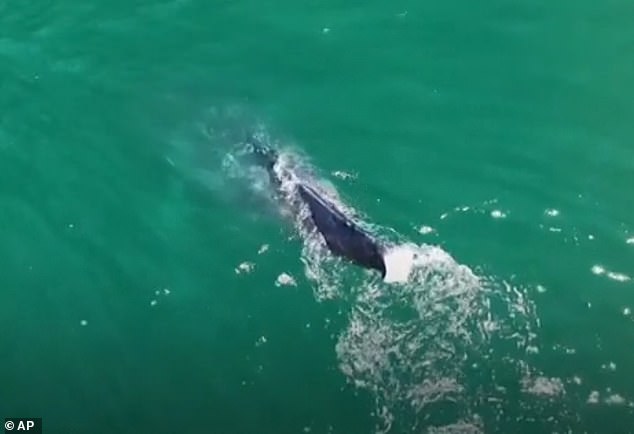Marine wildlife researchers recently made a heartbreaking discovery when they spotted a humpback whale in the ocean near Washington State.
The mammal had a devastating problem: it was missing a tail.
The spectacular aerial video filmed with a drone on July 23 shows the whale swimming along, and for a second, everything seems normal. That is, until the massive sea creature dives underwater and reveals its severed appendage.
Their iconic tail fins are their primary means of propelling themselves through the water, causing great concern among experts.
John Calambokidis, a research biologist at Cascadia Research Collective, said: The Associated Press that a humpback whale is unlikely to survive long without its fins.
As the whale dives, it becomes much more apparent that it is missing its caudal fins, which are crucial for propelling the mammal through the water.
Jessica Farrer, research director at the Whale Museum on Washington’s San Juan Island, was among a team of scientists who responded to the whale sighting in late July.
The whale was initially spotted in the Salish Sea, the inland waters between Washington and British Columbia.
But since then, there has been no other sighting, Farrer said.
“We all get a thrill when we watch a humpback whale dive and see these huge fins that are over 15 feet wide, and here’s this whale, it’s just lost them. It’s like us losing our legs,” Farrer said.
Farrer, along with many experts who have reviewed photographs of the whale, agree that it lost its fins due to entanglement.
The humpback whale may have become entangled in mooring lines, traps or nets, according to NOAA Fisheries.
The agency also says entangled marine life could be struck by ships while they are stationary.

This aerial photograph provided by The Whale Museum was taken near an island off the coast of Washington State on July 23, 2024. It shows a humpback whale with its tail missing.

The tailless humpback whale is seen exhaling water vapor through its blowhole.
“There are many entanglement hazards floating in the world’s oceans – old fishing gear that has broken off from fishing vessels or gear left behind by vessels,” Farrer said.
“And these whales have to swim through that and humpback whales are at greater risk because they have those very long pectoral fins.”
Farrer’s main concern about the tailless whale is that it won’t be able to swim fast enough to reach smaller fish for food.
NOAA Fisheries statistics show there were 16 confirmed humpback whale entanglements off the coasts of Washington, Oregon and California last year.
2016 was a particularly bad year for humpback whale entanglements, with a total of over 40.
This was likely due to the Dungeness crab fishing season in California that year, which could have meant a lot more fishing gear for the whales to try to navigate, AP reported.
California has since changed the way it regulates commercial Dungeness crab fishing in an attempt to protect the animals from entanglement.
Justin Viezbicke, a NOAA Fisheries first responder who works on whale entanglement cases, said there are sightings of finless whales along the West Coast about every year or two.

This is what a humpback whale’s tail typically looks like. The flukes can measure up to 15 feet wide from tip to tip.
He added that this anecdotal estimate likely greatly underestimates the actual number of whales that have lost their tails thanks to human intervention.
Calambokidis also said there are likely more tailless whales than have been reported so far.
Still, he said humpback whale populations off the West Coast are increasing and thriving despite the many dangers.
Farrer hopes the shocking images of this badly injured humpback whale will serve as a wake-up call and lead to even stricter protection measures.
‘It’s one thing to show pictures of entangled whales or talk about whales that have died from entanglement or see scars from entanglement, but this whale swimming in the Salish Sea completely tailless is the perfect example of the dangers they face.’


